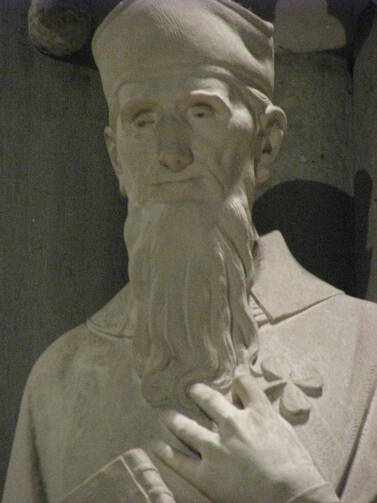Every March 17th, nearly everyone in the entire Irish Catholic world celebrates the feast of Saint Patrick. And just about everyone knows something about him: the legends, the fables, his apostolic works—but no one knows what he looked like. He is, of course, commonly portrayed as a somewhat older, bearded man, attired with bishop’s vestments, with a miter atop his head and a crozier, a pastoral staff, in his left hand. His right hand often points to that crozier, a symbol of his authority and, more importantly, his responsibility. More often than not, he is depicted amongst the flock he guided or, most famously, standing firmly near the sea, with his feet crushing the last of the snakes he supposedly banished from Irish shores, as legend has it. But still, no one knows what he looked like.
As happens all too often to seminal people in history, monuments and memorials are built in tribute to very human beings, like Patrick. And in these attempts the nuance of who the person was can be lost, their real self in danger of being buried beneath the elements of revered statuary. We too easily forget that we are not meant to preserve only the image of a person (or what we imagine that image might have been) but also their substance. What matters more than what Patrick looked like are the words and the deeds that survived him, for they echo through the centuries and influence the thoughts and practices of the people who he evangelized with such fervor, devotion and love. Indeed, there is an aspect of Patrick that we often fail to grasp which is as important a descriptor as well as an explanation of the man he was and the man he was to become.
You see, the man who became a saint was once a slave.
It is true that accounts of his life mention that fact of his being abducted from Roman Britain when he was 16 years old and being taken off by marauders to Ireland, where he spent years in the hills as a shepherd and caretaker of animals. Eventually, he escaped, returned home and finally embraced Christianity in earnest, becoming priest and bishop for his newfound flock. His return was only temporary, however. Patrick had often thought that if he could only get back to what he had known, all would be well and he would be restored—only it did not turn out that way. He did what we would not expect of someone recently enslaved—he definitively turned his back on his old life and returned (thanks to a dream) to the people who originally enslaved him. He become enslaved again—but this time willingly and of his own accord.
As a youth, Patrick was a slave to others’ bidding: he had no freedom, and his physical movements were limited. As a grown man, Patrick willingly became a slave of another sort—not only out of love for the God who saved him but also for the people who willingly accepted him and adopted him as one of their own. Through his apostolic works traversing the length and breadth of Ireland, Patrick not only transformed the cold and rote paganism of a people into warm and vibrant Christianity, he went further: he transformed the slavery that trapped him and them.
Saint Patrick turned his slavery into service. It was through his vision of Christianity that he turned oppression on its head and made service to others the outward expression of Christian belief and practice. This was to show in the numbers of churches that he had built and the untold numbers of people he baptized into new life, an achievement unheralded for his place and time. Patrick “Christianized” his slavery into service and made it worthy.
While he may have transformed his slavery into an act of service in his time, slavery as he had known it—as a repressive, evil—was still prevalent in his world and he condemned it in the strongest terms. He condemned Christians who practiced it upon one another; the most famous example of this was in his "Letter to Coroticus" and to the soldiers he led. Slavery was the antithesis of the Christianity he was given the opportunity to embrace and which he spent a lifetime spreading. The Christianity he was given in mercy was a faith he wanted to share with his adopted brethren. And it was because of that fact that Patrick became the first (and possibly the only) saint in the recorded history of Christianity to emphatically renounce it and condemn outright.
When you see a portrait or a painting, a statue or representation of the man and the saint named Patrick, remember the man that he was and what it was he tried to transform and know that there was more to him that the shamrock he held up for people to see; reflect, give thanks and give hail to the great apostle of Ireland who brought glory not only to God, but to his fellow man.








